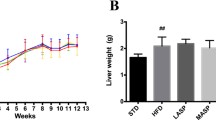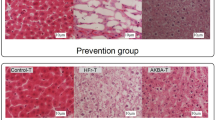Abstract
Objectives
In this study, we used an obese and diabetic mouse model to compare two strains of Aureobasidium pullulans (AFO-202 and N-163) produced beta-glucans (β-glucans), which alleviate lipotoxicity.
Methods
Four groups of KK-Ay mice were used, with six subjects in each group. Group 1: sacrificed on day 0 for baseline values; Group 2: control (drinking water); Group 3: AFO-202 beta glucan—200 mg/kg/day; Group 4: N-163 beta glucan—300 mg/kg/day for 28 consecutive days.
Results
Group 4 (N-163) had the lowest non-esterified fatty acids (NEFA) levels and marginally decreased triglyceride levels compared to the other groups. There were no significant differences in blood glucose, hemoglobin A1c (HbA1c), triglycerides, low-density lipoprotein (LDL), and high-density lipoprotein (HDL) cholesterol levels. N-163 β-glucans decreased NEFA levels after 28 days.
Conclusion
These results, although modest, warrant further in-depth research into lipotoxicity and associated inflammatory cascades in both healthy and diseased subjects for the prevention and management of metabolic dysregulation and associated diseases such as non-alcoholic fatty liver disease (NAFLD).




Similar content being viewed by others
Data availability
All data generated or analysed during this study are included in this manuscript.
Abbreviations
- NEFA:
-
Non-esterified fatty acids
- FFA:
-
Free fatty acids
- NASH:
-
Non-alcoholic steatohepatitis
- PDA:
-
Potato dextrose agar
- PDB:
-
Potato dextrose broth
- LDL:
-
Low-density lipoprotein
- HDL:
-
High-density lipoprotein
- ANOVA:
-
Analysis of variance
- NAFLD:
-
Non-alcoholic fatty liver disease
- STAM:
-
Stelic animal model
- TNF:
-
Tumour necrosis factor
- IL:
-
Interleukin
- PPARγ:
-
Peroxisome proliferator-activated receptor γ
References
The Nomenclature of Lipids. https://febs.onlinelibrary.wiley.com/doi/pdf/10.1111/j.1432-1033.1977.tb11778.x. Accessed 10 Dec 2022.
Boden G. Obesity, insulin resistance and free fatty acids. Curr Opin Endocrinol Diabetes Obes. 2011;18(2):139–43.
Holt HB, Wild SH, Wood PJ, Zhang J, Darekar AA, Dewbury K, Poole RB, Holt RI, Phillips DI, Byrne CD. Non-esterified fatty acid concentrations are independently associated with hepatic steatosis in obese subjects. Diabetologia. 2006;49(1):141–8.
Yazıcı D, Sezer H. Insulin resistance, obesity and lipotoxicity. Adv Exp Med Biol. 2017;960:277–304.
Fazio S. Fibrates — The Other Life-saving Lipid Drugs US Cardiology 2004;1(1):1–6.
Cloetens L, Ulmius M, Johansson-Persson A, Akesson B, Onning G. Role of dietary beta-glucans in the prevention of the metabolic syndrome. Nutr Rev. 2012;70(8):444–58.
Akramiene D, Kondrotas A, Didziapetriene J, Kevelaitis E. Effects of beta-glucans on the immune system. Medicina (Kaunas). 2007;43(8):597–606 (6777).
Dedeepiya V, Sivaraman G, Venkatesh A, Preethy S, Abraham S. Potential effects of Nichi glucan as a food supplement for diabetes mellitus and hyperlipidemia; preliminary findings from the study on three patients from India. Case Rep Med. 2012;2012:895370. https://doi.org/10.1155/2012/895370. https://www.biorxiv.org/content/10.1101/2021.07.22.453362v3. Accessed 10 Dec 2022.
Ganesh JS, Rao YY, Ravikumar R, Jayakrishnan AG, Iwasaki M, Preethy S, Abraham S. Beneficial effects of Black yeast derived 1–3, 1–6 beta glucan- Nichi Glucan in a dyslipidemic individual of Indian origin - A case report. J Diet Suppl. 2014;11(1):1–6.
Ikewaki N, Sonoda T, Kurosawa G, Iwasaki M, Dedeepiya VD, Senthilkumar R, Preethy S, Abraham SJK. Immune and metabolic beneficial effects of Beta 1,3–1,6 glucans produced by two novel strains of Aureobasidium pullulans in healthy middle-aged Japanese men: An exploratory study. medRxiv 2021.08.05.21261640; https://doi.org/10.1101/2021.08.05.21261640.
Castle CK, Colca JR, Melchior GW. Lipoprotein profile characterization of the KKA(y) mouse, a rodent model of type II diabetes, before and after treatment with the insulin-sensitizing agent pioglitazone. Arterioscler Thromb. 1993;13(2):302–9.
Lian Y, Xie L, Liu Y, Tang F. Metabolic-related markers and inflammatory factors as predictors of dyslipidemia among urban Han Chinese adults. Lipids Health Dis. 2019;18(1):167.
Liu J, Han L, Zhu L, Yu Y. Free fatty acids, not triglycerides, are associated with non-alcoholic liver injury progression in high fat diet induced obese rats. Lipids Health Dis. 2016;11(15):27.
Boden G. Free fatty acids, insulin resistance, and type 2 diabetes mellitus. Proc Assoc Am Phys. 1999;111(3):241–8.
Zhang J, Zhao Y, Xu C, Hong Y, Lu H, Wu J, Chen Y. Association between serum free fatty acid levels and nonalcoholic fatty liver disease: a cross-sectional study. Sci Rep. 2014;25(4):5832.
Bunn RC, Cockrell GE, Ou Y, Thrailkill KM, Lumpkin CK Jr, Fowlkes JL. Palmitate and insulin synergistically induce IL-6 expression in human monocytes. Cardiovasc Diabetol. 2010;5(9):73.
Zhu Y, Yao Y, Gao Y, Hu Y, Shi Z, Ren G. Suppressive effects of barley β-Glucans with different molecular weight on 3T3-L1 Adipocyte differentiation. J Food Sci. 2016;81(3):H786–93.
Rodrigues MV, Zanuzzo FS, Koch JFA, de Oliveira CAF, Sima P, Vetvicka V. Development of fish immunity and the role of β-Glucan in immune responses. Molecules. 2020;25:5378.
Ikewaki N, Fujii N, Onaka T, Ikewaki S, Inoko H. Immunological actions of Sophy beta-glucan (beta-1,3–1,6 glucan), currently available commercially as a health food supplement. Microbiol Immunol. 2007;51(9):861–73.
Ikewaki M, Iwasaki M, Kurosawa G, Rao KS, Beitia JL, Preethy S, Abraham SJ. β-Glucans: Wide-spectrum Immune-balancing Food-supplement-based Enteric (β-WIFE) Vaccine Adjuvant Approach to COVID-19. Hum Vaccin Immunother 2021; 17. https://doi.org/10.1080/21645515.2021.1880210.
Noss I, Ozment TR, Graves BM, Kruppa MD, Rice PJ, Williams DL. Cellular and molecular mechanisms of fungal β-(1→6)-glucan in macrophages. Innate Immun. 2015;21:759–69.
Samkani A, Skytte MJ, Anholm C, Astrup A, Deacon CF, Holst JJ, Madsbad S, Boston R, Krarup T, Haugaard SB. The acute effects of dietary carbohydrate reduction on postprandial responses of non-esterified fatty acids and triglycerides: a randomized trial. Lipids Health Dis. 2018;17(1):295.
Ikewaki N, Kurosawa G, Iwasaki M, Preethy S, Dedeepiya VD, Vaddi S, Senthilkumar R, Levy GA, Abraham SJK. Hepatoprotective effects of Aureobasidium pullulans derived Beta 1,3–1,6 biological response modifier glucans in a STAM- animal model of non-alcoholic steatohepatitis. J Clin Exp Hepatol. 2022. https://doi.org/10.1016/j.jceh.2022.06.008.
Acknowledgements
The authors would like to dedicate this paper to the memory of Mr. Takashi Onaka, who passed away on the 1st of June, 2022 at the age of 90 years, who played a pivotal role in successfully culturing and industrial scale up of AFO-202 and N-163 strains of Aureobasidium pullulans after their isolation and standardization of the process of producing the novel beta glucans described in this study.
The authors thank
a. Mr. Yoshio Morozumi, Ms. Yoshiko Amikura of GN Corporation, Japan for their liaison assistance with the conduct of the study.
b. Ms. Eiko Amemiya of the II Department of Surgery, University of Yamanashi for her secretarial assistance.
c. Loyola-ICAM College of Engineering and Technology (LICET) for their support to our research work.
Author information
Authors and Affiliations
Contributions
N.I and S.A. contributed to conception and design of the study. Y.I and M.N helped with technical assistance. R.S helped in literature search. S.A, M.R and S.P. drafted the manuscript. G.K, V.D and S.V performed critical revision of the manuscript. All the authors read, and approved the submitted version.
Corresponding author
Ethics declarations
Ethics approval
The protocol approval was obtained from the ethics committee of Toya Laboratory, HOKUDO Co., Japan (Ref no: HKD47047). The study was conducted in accordance with the HOKUDO Animal Experiment Regulations following the Act on Welfare and Management of Animals (Ministry of the Environment, Japan, Act No. 105 of October 1, 1973), standards relating to the care and management of laboratory animals and relief of pain (Notice No.88 of the Ministry of the Environment, Japan, April 28, 2006) and the guidelines for proper conduct of animal experiments (Science Council of Japan, June 1, 2006). All animal experiments took place at Toya Laboratory, HOKUDO Co., Hokkaido, Japan.
Potential conflict of interests
Author Samuel Abraham is a shareholder in GN Corporation, Japan which holds shares of Sophy Inc., Japan., the manufacturers of novel beta glucans using different strains of Aureobasidium pullulans; a board member in both the companies and also an applicant to several patents of relevance to these beta glucans.
Additional information
Publisher's note
Springer Nature remains neutral with regard to jurisdictional claims in published maps and institutional affiliations.
Pre-prints
The article has been posted on the preprint server, bioRxiv, https://doi.org/10.1101/2021.07.22.453362
Rights and permissions
Springer Nature or its licensor (e.g. a society or other partner) holds exclusive rights to this article under a publishing agreement with the author(s) or other rightsholder(s); author self-archiving of the accepted manuscript version of this article is solely governed by the terms of such publishing agreement and applicable law.
About this article
Cite this article
Ikewaki, N., Ikeue, Y., Nagataki, M. et al. Beneficial effects of 1,3–1,6 β-glucans produced by Aureobasidium pullulans on non-esterified fatty acid levels in diabetic KKAy mice and their potential implications in metabolic dysregulation. J Diabetes Metab Disord 22, 487–494 (2023). https://doi.org/10.1007/s40200-022-01170-5
Received:
Accepted:
Published:
Issue Date:
DOI: https://doi.org/10.1007/s40200-022-01170-5




